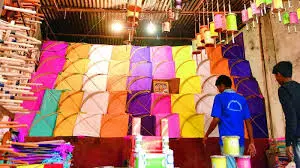Sankranti celebrations a legacy rooted in AP’s traditions

The festival of Sankranti, celebrated widely in Andhra Pradesh, is deeply connected to the region's history, spirituality and agrarian traditions. (Image: DC)
Tirupati: The festival of Sankranti, celebrated widely in Andhra Pradesh, is deeply connected to the region's history, spirituality and agrarian traditions. It marks the Sun's transition into Makara (Capricorn), heralding the end of winter and beginning of the harvest season.
Sankranti’s roots can be traced to the Vedic era. Ancient scriptures like Rig Veda and Yajur Veda emphasise the importance of the Sun as a divine force sustaining life on Earth. There is also archaeological evidence that underscores the timeless significance of the festival from the Vedic era.
The festival marks the end of Dakshinayana (the southward journey of the Sun) and the beginning of Uttarayana (northward movement), symbolising the transition from darkness to light, along with material prosperity. "The Mahabharata refers to this time as sacred, as Bhishma Pitamaha chose to leave his mortal body during Uttarayana" explains Pandit Ramachandra Sharma, a historian and spiritual guide.
Sankranti’s spiritual significance is also intertwined with cultural aspects. Archaeological findings from the Satavahana and Chalukya periods highlight the deep roots of solar worship and harvest-related festivities.
Dr. K. Venkatesh, a retired professor of history, observes, "Satavahanas formalised agricultural and trade practices in the Deccan. Harvest festivals like Sankranti likely evolved during this time, blending spiritual observance with social celebration."
During the Vijayanagara Empire, the celebrations became more elaborate, incorporating dance, music and folk performances. The rulers, known for their patronage of agriculture and art, promoted communal festivities to foster social harmony.
“My grandmother used to tell me stories of Sankranti celebrations during the reign of local zamindars, who distribute food and gifts to farmers. It was not just a festival but a way of life that united people across classes”, recalled Lakshmiamma, an octogenarian from Madanapalle.
“Sankranti is our thanksgiving to nature. It is a festival of sharing, rejoicing and honouring the hard work that goes into cultivating the land. I still remember my grandfather telling me how the entire village would come together to celebrate, forgetting their hardships,” Narasimha Reddy, an elderly farmer from Nellore told Deccan Chronicle.
Today, Sankranti spans three days. The first, Bhogi, involves bonfires to discard old agricultural waste, symbolising purification. The second, Makara Sankranti, features prayers, rituals and delicacies like pongal, ariselu and murukulu. The third day, Kanuma, honours cattle, essential to farming.
Sankranti in Andhra Pradesh is celebrated with diverse customs. In Konaseema region, the highlight is Prabhala Teertham, a procession honouring Lord Shiva. Coastal Andhra celebrates Sankranti with bullock cart races and spirited rooster fights, despite police prohibiting it. In Kadapa and Anantapur, kite flying is popular, while women showcase creativity through intricate ‘Muggulu’ (rangolis). In Chittoor and Tirupati districts, the Pasuvula Panduga celebrates cattle, vital to agrarian life. Farmers adorn bulls with ornaments, paint, and garlands, and organise races and strength contests.
A distinct aspect of Sankranti in Andhra Pradesh is the Haridasu tradition, where devotees in saffron robes sing Lord Vishnu’s praises while playing the tambura, blessing families and receiving alms. Equally captivating is the Gangireddu Aata, featuring vibrantly adorned, trained bulls performing tricks, a tradition cherished in rural folklore.
The festival marks the end of Dakshinayana (the southward journey of the Sun) and the beginning of Uttarayana (northward movement), symbolising the transition from darkness to light, along with material prosperity. "The Mahabharata refers to this time as sacred, as Bhishma Pitamaha chose to leave his mortal body during Uttarayana" explains Pandit Ramachandra Sharma, a historian and spiritual guide.
Sankranti’s spiritual significance is also intertwined with cultural aspects. Archaeological findings from the Satavahana and Chalukya periods highlight the deep roots of solar worship and harvest-related festivities.
Dr. K. Venkatesh, a retired professor of history, observes, "Satavahanas formalised agricultural and trade practices in the Deccan. Harvest festivals like Sankranti likely evolved during this time, blending spiritual observance with social celebration."
During the Vijayanagara Empire, the celebrations became more elaborate, incorporating dance, music and folk performances. The rulers, known for their patronage of agriculture and art, promoted communal festivities to foster social harmony.
“My grandmother used to tell me stories of Sankranti celebrations during the reign of local zamindars, who distribute food and gifts to farmers. It was not just a festival but a way of life that united people across classes”, recalled Lakshmiamma, an octogenarian from Madanapalle.
“Sankranti is our thanksgiving to nature. It is a festival of sharing, rejoicing and honouring the hard work that goes into cultivating the land. I still remember my grandfather telling me how the entire village would come together to celebrate, forgetting their hardships,” Narasimha Reddy, an elderly farmer from Nellore told Deccan Chronicle.
Today, Sankranti spans three days. The first, Bhogi, involves bonfires to discard old agricultural waste, symbolising purification. The second, Makara Sankranti, features prayers, rituals and delicacies like pongal, ariselu and murukulu. The third day, Kanuma, honours cattle, essential to farming.
Sankranti in Andhra Pradesh is celebrated with diverse customs. In Konaseema region, the highlight is Prabhala Teertham, a procession honouring Lord Shiva. Coastal Andhra celebrates Sankranti with bullock cart races and spirited rooster fights, despite police prohibiting it. In Kadapa and Anantapur, kite flying is popular, while women showcase creativity through intricate ‘Muggulu’ (rangolis). In Chittoor and Tirupati districts, the Pasuvula Panduga celebrates cattle, vital to agrarian life. Farmers adorn bulls with ornaments, paint, and garlands, and organise races and strength contests.
A distinct aspect of Sankranti in Andhra Pradesh is the Haridasu tradition, where devotees in saffron robes sing Lord Vishnu’s praises while playing the tambura, blessing families and receiving alms. Equally captivating is the Gangireddu Aata, featuring vibrantly adorned, trained bulls performing tricks, a tradition cherished in rural folklore.
( Source : Deccan Chronicle )
Next Story

